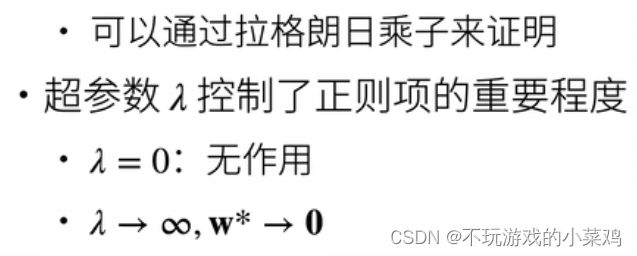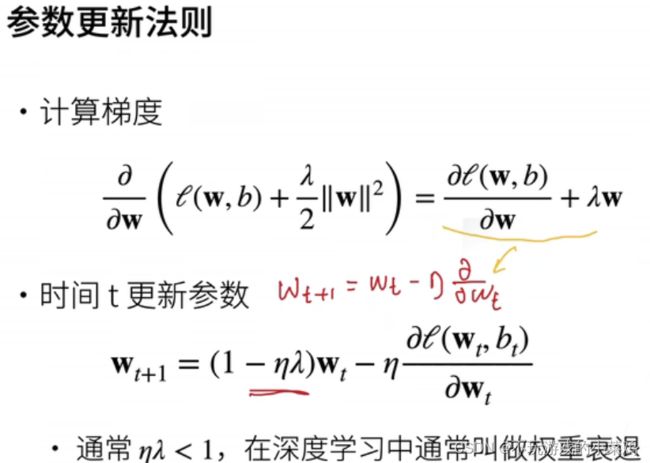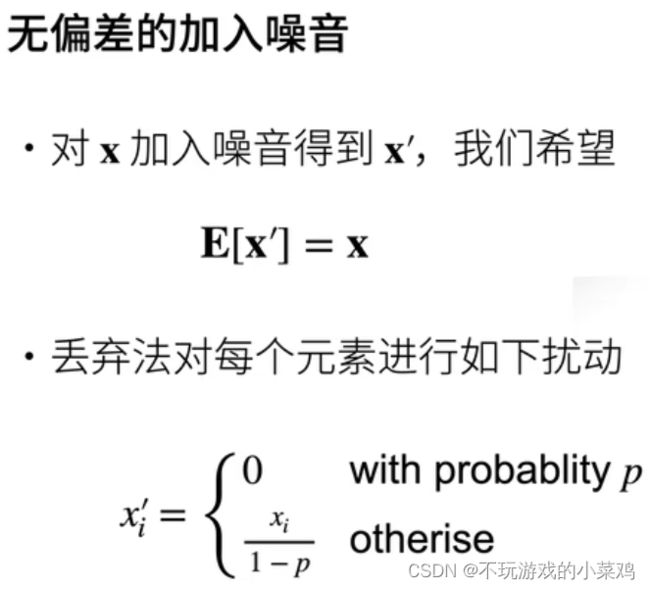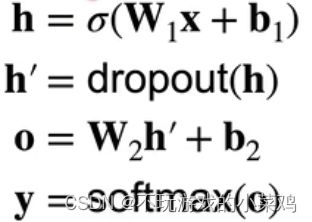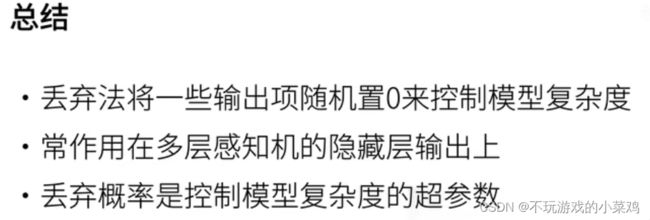0901权重衰退
处理过拟合
控制模型容量:1.模型参数变少 2.模型参数范围变小
权重衰退:为处理过拟合的用得比较多的方法
最理想的状态是达到0.
1/2是为了求导后计算方便(系数为1了)
前面是严格限制了范围,故为硬性限制,而此处是增加了一个罚项,相比较则为柔性限制
Dropout -- 丢弃法
(鲁棒是Robust的音译,也就是健壮、强壮、坚定、粗野的意思。鲁棒性(robustness)就是系统的健壮性。)
加噪音不改变期望
丢弃法:一定概率变0,一定概率变大
由此公式可得到需要的E[x'] = x
h为第一个隐藏层的输出
推理中的丢弃法
丢弃概率多取0.5, 0.9, 0.1
Dropout是一个正则项,对模型更新不明显,对。 求梯度对称
dropout 随机丢弃,精度高,随机性让模型更稳定
只是在训练中把神经元丢弃,预测中神经元不丢弃
代码实现
权重衰减
权重衰减是最广泛使用的正则化的技术之一
%matplotlib inline
import torch
from torch import nn
from d2l import torch as d2l
n_train, n_test, num_inputs, batch_size = 20, 100, 200, 5
true_w, true_b = torch.ones((num_inputs, 1)) * 0.01, 0.05
train_data = d2l.synthetic_data(true_w, true_b, n_train)
train_iter = d2l.load_array(train_data, batch_size)
test_data = d2l.synthetic_data(true_w, true_b, n_test)
test_iter = d2l.load_array(test_data, batch_size, is_train=False)初始化模型参数
def init_params():
w = torch.normal(0, 1, size=(num_inputs, 1), requires_grad=True)
b = torch.zeros(1, requires_grad=True)
return [w, b]定义L2范数惩罚
def l2_penalty(w):
return torch.sum(w.pow(2)) / 2定义训练代码实现
def train(lambd):
w, b = init_params() #初始化
net, loss = lambda X: d2l.linreg(X, w, b), d2l.squared_loss #线性回归 平方损失函数
num_epochs, lr = 100, 0.003
animator = d2l.Animator(xlabel='epochs', ylabel='loss', yscale='log',
xlim=[5, num_epochs], legend=['train', 'test']) #动画效果
for epoch in range(num_epochs):
for X, y in train_iter:
#with torch.enable_grad():
l = loss(net(X), y) + lambd * l2_penalty(w)
l.sum().backward()
d2l.sgd([w, b], lr, batch_size)
if (epoch + 1) % 5 == 0:
animator.add(epoch + 1, (d2l.evaluate_loss(net, train_iter, loss),
d2l.evaluate_loss(net, test_iter, loss)))
print('w的L2范数是:', torch.norm(w).item())忽略正则化直接训练
train(lambd=0) #无惩罚
1
结果:w的L2范数是: 13.713445663452148
使用权重衰减
train(lambd=3)
1
结果:w的L2范数是: 0.3729381859302521
简洁实现
def train_concise(wd):
net = nn.Sequential(nn.Linear(num_inputs, 1))
for param in net.parameters():
param.data.normal_()
loss = nn.MSELoss()
num_epochs, lr = 100, 0.003
trainer = torch.optim.SGD([{
"params": net[0].weight,
'weight_decay': wd}, {
"params": net[0].bias}], lr=lr)
animator = d2l.Animator(xlabel='epochs', ylabel='loss', yscale='log',
xlim=[5, num_epochs], legend=['train', 'test'])
for epoch in range(num_epochs):
for X, y in train_iter:
with torch.enable_grad():
trainer.zero_grad()
l = loss(net(X), y)
l.backward()
trainer.step()
if (epoch + 1) % 5 == 0:
animator.add(epoch + 1, (d2l.evaluate_loss(net, train_iter, loss),
d2l.evaluate_loss(net, test_iter, loss)))
print('w的L2范数:', net[0].weight.norm().item())train_concise(0)
1
结果:w的L2范数: 12.6707124710083
train_concise(3)
1
结果:w的L2范数: 0.350588858127594
pycharm完整代码:
import torch
import torch.nn as nn
import numpy as np
import sys
sys.path.append(".")
import d2lzh_pytorch as d2l
import sys
from matplotlib import pyplot as plt
"""
生成一个人工数据集,还是一个线性回归的问题,
偏差0.05+权重0.01乘以随机的输入x然后+噪音,均值为0,方差为0.01的正态分布
"""
n_train, n_test, num_inputs = 20, 100, 200
# 训练数据集越小,越容易过拟合。训练数据集为20,测试数据集为100,特征的纬度选择200.
# 数据越小,模型越简单,过拟合越容易发生
true_w, true_b = torch.ones(num_inputs, 1) * 0.01, 0.05
# 真实的权重就是0.01*全1的一个向量,偏差b为0.05
"""
读取一个人工的数据集
"""
features = torch.randn((n_train + n_test, num_inputs)) # 特征
labels = torch.matmul(features, true_w) + true_b # 样本数
labels += torch.tensor(np.random.normal(0, 0.01, size=labels.size()), dtype=torch.float)
train_features, test_features = features[:n_train, :], features[n_train:, :]
train_labels, test_labels = labels[:n_train], labels[n_train:]
"""
初始化模型,该函数为每个参数都附上梯度
"""
def init_params():
w = torch.randn((num_inputs, 1), requires_grad=True)
b = torch.zeros(1, requires_grad=True)
return [w, b]
"""
定义L2范数惩罚,只惩罚模型的权重参数
"""
def l2_penalty(w):
return (w ** 2).sum() / 2
"""
定义训练和测试模型
"""
batch_size, num_epochs, lr = 1, 100, 0.003
net, loss = d2l.linreg, d2l.squared_loss
dataset = torch.utils.data.TensorDataset(train_features, train_labels)
train_iter = torch.utils.data.DataLoader(dataset, batch_size, shuffle=True)
def fit_and_plot(lambd):
w, b = init_params()
train_ls, test_ls = [], []
for _ in range(num_epochs):
for X, y in train_iter:
# 添加了L2范数惩罚项
l = loss(net(X, w, b), y) + lambd * l2_penalty(w)
l = l.sum()
if w.grad is not None:
w.grad.data.zero_()
b.grad.data.zero_()
l.backward()
d2l.sgd([w, b], lr, batch_size)
train_ls.append(loss(net(train_features, w, b), train_labels).mean().item())
test_ls.append(loss(net(test_features, w, b), test_labels).mean().item())
d2l.semilogy(range(1, num_epochs + 1), train_ls, 'epochs', 'loss',
range(1, num_epochs + 1), test_ls, ['train', 'test'])
print('L2 norm of w:', w.norm().item())
fit_and_plot(lambd=0)
plt.show()

